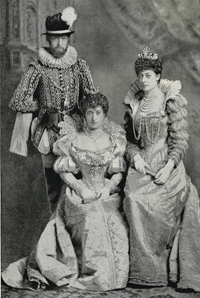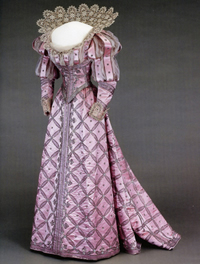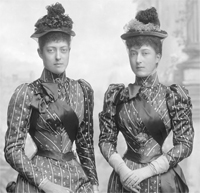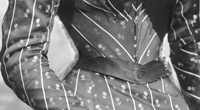Prince and Princess Carl of Denmark,
The Ball took place just under a year after Princess Maud of Wales (centre), daughter of the Prince and Princess of Wales, married her first cousin, the second son of the future King Frederick VIII of Denmark. The choice of role at the ball, as ladies-in-waiting to Marguerite de Valois, by Maud and her unmarried younger sister Victoria may well have been dictated, or at least, swayed by their mother Princess Alexandra. According to Frances Dimond, Princess Victoria (right), “although sensitive and reserved, ...had a great sense of fun and was good company, lacking any affectation or grandeur. She enjoyed bicycling and horse-riding, designed her own bookbindings, loved reading, music, and dancing, and was a very enthusiastic amateur photographer, who compiled many albums and took part in Kodak exhibitions.” The princess never married, but remained a companion to her mother and passed away just ten years after her mother’s death. At the time of the Ball in 1897, the couple (known as Prince and Princess Charles of Denmark) had no inkling that they would be chosen as the king and queen of Norway in 1905. Maud had grown up in what has been described as “a loving, cheerful environment and [she] was noted for mischief and high spirits.” Both Maud and her husband had many interests and talents and it was written of them, just a few years after they ascended the throne of the newly reconstituted kingdom of Norway, that “King Haakon and Queen Maud are gathering about them the literary, artistic, and musical people of the realm, for they are devoted to the companionship of gifted folk.” Maud’s dress was of pink satin with an appliqué of sheer silk fabric with silver thread in a lattice pattern edged with silver sequins and silver and glass beads. The fan-like collar wired to the side and back edges of the bodice and the cuffs, also of lace, are decorated with diamonté rosettes. The gown was made by the French firm of Victoire Morin and Marie Blossier, who opened for business in 1878, and whose greatest success was in the years 1885 to 1905. In order to achieve a faithful renaissance look, both Princesses are wearing costume, rather than their own, real, jewellery in their hair and about their costumes. |
Click on image to enlarge  From Munsey's magazine From Munsey's magazine
|
||||
|



